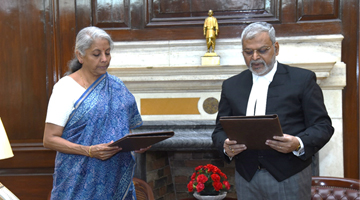I-T - Whether date of agreement and not date of execution of sale deed is to be considered for purpose of adopting SRO value u/s 50C - YES: ITAT
By TIOL News Service
HYDERABAD, JAN 12, 2016: THE issue is - Whether date of agreement and not date of execution of sale deed is to be considered for purpose of adopting SRO value u/s 50C. YES is the answer.
Facts of the case
The assessees herein are all family members of two brothers, Shri Mohd. Zia Baig and Shri Abdul Arif Baig. The family members of Shri Mohd. Zia Baig and Shri Abdul Arif Baig, owned adjacent immovable properties at Hyderabad and the shares of all the assessees in the properties are specified. They sold their properties together for a sale consideration of Rs.3,35,60,000 vide registered document No.1264 of 2006 and Rs.3,54,40,000 vide Regd. Document No.1262 of 2006 both dated 6.3.2006. The sale consideration was shared by the co-owners in the ratio of their land ownership. The assessees computed long term capital gains from the above transaction on the sale consideration received by them and arrived at the long term capital gains in the hands of each of these assessees. Subsequently, it came to the notice of the Department that the market value of the property in the above transaction was adopted at Rs.4,50,62,000 by the Sub-Registrar for the purposes of payment of stamp duty at the time of registration.
Observing that the capital gains should have been computed adopting the deemed consideration of Rs.4,50,62,000 as per the provisions of S.50C of the I.T. Act, the AO held that proportionate deemed consideration has to be brought to tax. Since the assessee failed to adopt the deemed consideration as per the provisions of S.50C, he held that the capital gains was short admitted. In view of the same, the AO formed an opinion that there was reason to believe that income chargeable to tax has escaped assessment within the meaning of S.147 of the Act. Therefore, notices under S.148 were issued to all the assessees in response to which the assessees have filed their returns of income, admitting the same incomes, which were admitted in the original returns of income.
During the reassessment proceedings, it was submitted that the sale deeds in respect of the above property was executed on 6.3.2006 and were registered on 10.3.2006 vide Document No.1261 and 1262 of 2006; and that the Sub-Registrar, Hyderabad adopted the market value of the said properties at Rs.4,50,62,000, for an area of 1785 sq. yards which works out to Rs.25,444 per sq. yard on the basis of the guide line value relating to the commercial area which is Rs.25,000 per sq. yard. He submitted that the value adopted by the Sub- Registrar is totally wrong and baseless, because the property was in residential area and not in commercial area.
It was also submitted that even though circle rates are applied in respect of valuation of land in an area, there could be huge variations in the prices of land falling even within the circle on account of location factors and hence same value cannot be adopted for all the plots in the area. It was accordingly requested to drop the proceedings initiated under S.147 of the Act.
The AO, however, rejected the objections of the assessee and proceeded to compute the long term capital gains by invoking the provisions of S.50C of the Act. Since the assessees objected to the adoption of SRO value as Fair Market Value of the properties, he made a reference to the DVO of the Income-tax Department for ascertaining the Fair Market Value of the property as on the date of transfer. The DVO, after inspection of the property and verification of the relevant documents proceeded to estimate the market value of the property at Rs.4,51,71,285 and a show cause was accordingly issued to the assessees. The assessees filed their objections to the proposed valuation. The assessees also reiterated the objections raised against the reopening of the assessment. The DVO, however, estimated the Fair Market Value of the property as on 6.3.2006 at Rs.4,51,71,285, vide orders under S.16A(4) of the Wealth Tax Act read with S.50C of the Income-tax Act.
After forwarding the copy of the order of the DVO to the assessees, the AO proposed to adopt the Fair Market Value at Rs.4,50,70,285 as adopted by the SRO for stamp duty purposes. The assessees again filed their objections. The AO, however, was not convinced with the contentions of the assessee and adopting the Fair Market Value at Rs.4,50,62,000 as deemed total consideration for the sale of the property, computed the capital gains accordingly in the hands of all the other co-owners.
Before the CIT(A), according to the assessees, the SRO value of the property as on the date of agreement has to be considered and not as on the date of the transfer of the property. The assessee also relied on the first proviso to S.56(2)(vii)(b) of the Act which provides that for the purposes of S.50C of the Act, where the SRO value on the date of agreement fixing the amount of consideration for the transfer of the immovable property and the date of registration are not the same, the stamp duty value on the date of the agreement may be taken for the purpose of that section.
As regards the merits of the valuation by the DVO, the CIT(A) rejected the assessee's contention that the SRO value for commercial property cannot be applied to a residential property. Even with regard to the irregular shape of land and the lack of direct access to main road and such other aspects of the said property, contentions of the assessee were rejected by the CIT(A) by holding that the alleged negative aspects were apparently negligible enough to be ignored by the purchaser to offer a price that was much higher than the SRO rate, as contended by the assessee. Thus, the assessment order was confirmed by the CIT(A).
On further appeal by the assessee, the Tribunal held that,
++ the issue is as to whether the date of agreement or the date of execution of sale deed has to be considered for the purpose of adopting the SRO value under S.50C of the Act. This issue is now settled in favour of the assessee by the decisions of the Supreme Court in the case of Sanjeev Lal and Smt. Shantilal Motilal V/s. CIT - 2014-TIOL-63-SC-IT as well as decisions of the coordinate bench of this Tribunal at Visakhapatnam in the cases of M/s. Lahiri Promoters Visakhapatnam V/s. ACIT, Circle 1(1), Visakhapatnam (ITA No.12/Vizag/2009 dated 22.6.2010) and Moole Rami Reddy V/s. ITO - 2011-TIOL-135-ITAT-VIZAG. It is therefore, now settled that the SRO value as on the date of agreement of sale has to be considered for the purpose of computation;
++ In the instant case, the date of agreement of sale or MOU is allegedly dated 20.5.2005, but the said document was not produced before any of the authorities till date. Though the assessee has claimed to have received the advance of Rs.60,000 in cash on the date of MOU, there is no evidence in support of the cash payment, as contended by the assessee. There is not even a receipt issued in evidence thereof. Therefore, the moot question is whether the recitals in the sale deed alone can be considered as the evidence in support of the MOU. None of the authorities below have examined this issue as they have proceeded on the premise that the date of execution of sale deed is the date to be considered for valuation under S.50C;
++ A transaction involving such immovable property in such prime locality of the city of Hyderabad and involving such financial implications would definitely not take place overnight. The purchaser would require time to verify the legal and clear title of the owners and also about the encumbrances on the property before proceeding to make the payment and get the sale deeds executed. All this would consume time and money. For this purpose, they would have negotiated with the owners about the sale consideration before embarking on this exercise. Therefore, it cannot be said that the transaction has been agreed to as well as executed on the same date. Thus, there had to be an agreement to sell, either oral or in writing. But what is such date is the question before us and this date attains importance because it would determine the SRO value to be taken into consideration for computation of capital gains. It is only the recitals in the sale deed about the MOU dated 20.5.2005 and no other document. The advance of Rs.60,000/- is allegedly in cash with no evidence in support of the same. Even the certificate of the SRO for market value as on 20.5.2005 is dated 3.11.2011 which is after the filing of the return of income by the respective assessees, but before the issuance of notice under S.148 dated 1.3.2013 for initiation of re-assessment proceedings Since no concrete material is filed in support of the MOU dated 20.5.2005, the same cannot be accepted, particularly, since there was a revision of guideline values of the properties in 2006. The SRO has taken the revised guideline value and the date on which such revision has taken place also is not available on record;
++ The next question is the nature of the property for valuation under S.50C. There cannot be any dispute that the nature of the property on the date of transfer/sale is to be considered. As pointed out by the counsel for the assessee, the encumbrance certificate mentions the property as residential property, but as rightly held by the CIT(A), Encumbrance Certificate merely reflects the registration of the documents and no more can be read into this description. But the counsel for the assessee had also relied upon the GO(Ms) No.574 M.A. dated 25.8.21980 and the letter dated 26.3.2013 issued by the Director(Planning), HMDA certifying that Road No.3, Banjara Hills, near Sultan-Ul-Uloom Engineering College, as earmarked for residential use, as per the above G.O. None of the authorities below have commented adversely about this document, but in fact have remained silent on the same. This letter issued by the concerned relevant authority is relevant to determine the nature of the property. It is also a fact that even in a residential zone, one may put a property to commercial use by which it would fetch commercial value when sold. But in the instant case, there is no such allegation by the revenue. But, in fact, the contention of the assessee that the property remained as it is even after eight years of sale also confirms this position, as no person would keep such a property idle when there was ample development potential. The above fact of the land remaining as it is has not been controverted by the authorities below. Therefore, for want of any evidence to the contrary, the property in question was in residential zone on the date of transfer and therefore, the SRO value for residential property as on 6.3.2006 or the sale consideration received by the assessee whichever is higher is to be adopted under S.50C of the Act. AO was directed to compute the capital gains in the hands of the respective assessees accordingly.
(See 2016-TIOL-67-ITAT-HYD)














